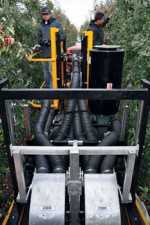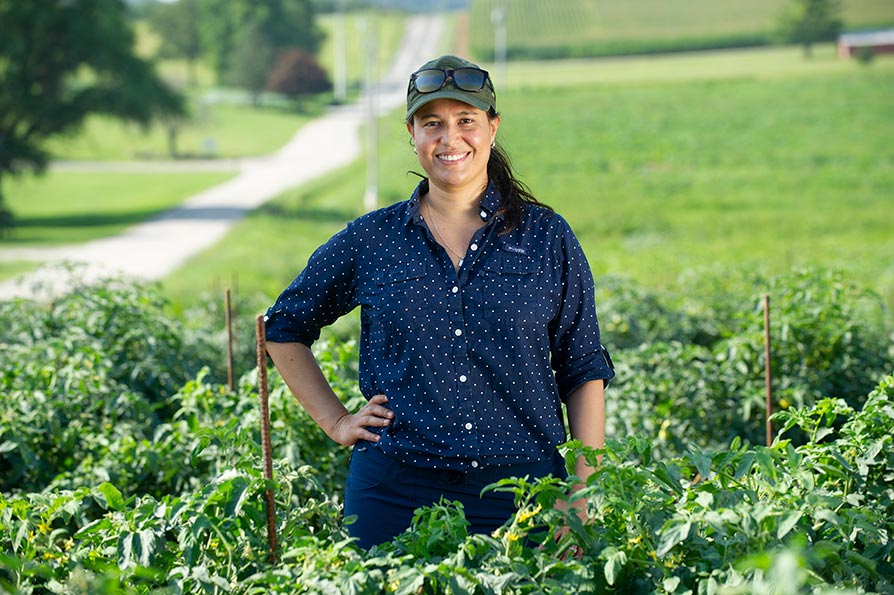Apple Harvester is Getting Closer to Reality

It was just a couple years ago that Michigan apple growers Mike Rasch and Chuck Dietrich, along with equipment guru Phil Brown of Phil Brown Welding in Conklin, MI, got together to form DBR Conveyor Concepts, LLC. The three had been working together on the development of an apple harvesting prototype that uses a vacuum system to pull picked fruit into bins on a trailer. Their goal was to create a model that would maximize labor efficiency, minimize fruit bruising, and be adaptable to different equipment. DBR would serve as a way to develop, manufacture, and market the machine, bringing the expertise of all three men into the mix.
2011 marked the first full year of field testing, and it was not limited to Michigan. Different models of the prototype were sent to Pennsylvania and Washington for evaluation, giving university researchers and growers the chance to trial the device in their own unique regions.
“We tested the DBR machine in Washington last season for five weeks,” says Karen Lewis, a tree fruit Extension horticulturist at Washington State University. “We mostly spent time getting the machine up to our thresholds. We worked in several architectures, varieties, and harvest scenarios.”
While harvest efficiency improved by about 20% compared to ladders, it was clear that some modifications were still necessary to reduce bruising and limit the number of culls.
Making Adjustments
This past winter, the DBR team set to work making these necessary modifications. “We have the vacuum and bruising pretty much conquered, so now we’re making a bunch of changes to help efficiency and improve bin leveling,” says Brown.
Leveling was perhaps the biggest focus in the modifications. “We added a hydraulic side level to keep the platform more level to the tree, and keep the bin level in all four directions, so a grower can fill the bin even or all the way up,” says Brown. “We also designed a feature on the bin filler that allows it to fill the box more level if someone is picking from just one side of the machine, like an outside row,” notes Rasch, who also points out the importance of recognizing the differences between Michigan and Washington in orchard design and variety mix. “They have solid variety plantings out west, and our varieties are interplanted, sometimes row by row.”
What’s On Tap For 2012
As of early June, these renovated models were scheduled to be shipped back out across the country for further review for this coming season. Here’s a brief look at what researchers are looking for:
• Pennsylvania: “We are currently looking more closely at the tube flow characteristics of the vacuum-driven harvesting unit,” says Paul Heinemann, a professor in Penn State University’s Department of Agricultural and Biological Engineering. “This includes power requirements to create sufficient negative pressure to move fruit of different sizes through the tubes, gravity-assist, and velocities of the fruit (and its effect on impact potential). Our goal is to optimize the power requirement to improve the efficiency of the unit, using only enough energy as needed.”
Heinemann notes that the extent of future testing and development will depend on their success with Specialty Crop Research Initiative funding; however, “DBR continues to work on development regardless of the funding situation.”
• California/Washington: On its trip westward, the DBR will first land in California, where it will undergo five weeks of testing during peach and pear harvest. From there, it will go back up to Washington.
“We hope that with the modifications we can focus on operation efficiencies,” says Lewis. “We will focus on tops of canopies and run two shifts per day, depending on the variety and the weather.”
• Michigan: While the DBR team will be using a slightly modified version from the one in Washington, their goal is to roll both versions together into one model, says Rasch.
The one factor that could have an effect on trial results in Michigan this year is weather. A warm spring, followed by frosts in April and early May, have contributed to spotty crop conditions. “We’re on board with the Michigan Apple Committee and researchers to do trials for the fall fruit season in four fruit areas,” says Rasch. ”But we don’t know what the crop will be in those regions. We’re still gearing up, and will go where we have to. At the very least, with the yield down, it could affect efficiency.” Rasch points out, however, that the wide range of data available from Washington could make up for this.
Landmark Technology
So how close is the DBR model to being available for commercial use? “We hope it will be ready for 2013,” says Brown. “But we’ll likely make a few more changes along the way.”
Rasch says the partnerships between researchers, engineers, and growers have gone a long way to bring the DBR system closer to fruition. “We’re very grateful for that.”
One of the most optimistic individuals involved in the testing is Phil Schwallier, district horticultural marketing agent at Michigan State University. ”I believe this is a landmark technology change in the fruit industry,” says Schwallier. “It is one of the first machines that will actually machine assist apple harvest and could replace the long traditional hand-picked bag system.”
Not Just For Harvest
Perhaps the most significant benefit of the DBR model, according to Mike Rasch, is that it will have year-round application. The blower and vacuum system can be easily removed so that the platform can be freed up for other purposes, from thinning to pruning. “We wanted a way to help growers use the tractors they already own to carry it,” says Rasch.
For More Information
Want to keep up with new developments with the DBR as well as other orchard technology? Head to www.cascrop.com, the website for the Comprehensive Automation for Specialty Crops program. You can watch videos of new equipment in action, learn more about the expert teams involved in research trials, and get a first-hand look at what’s being talked about across the country.










